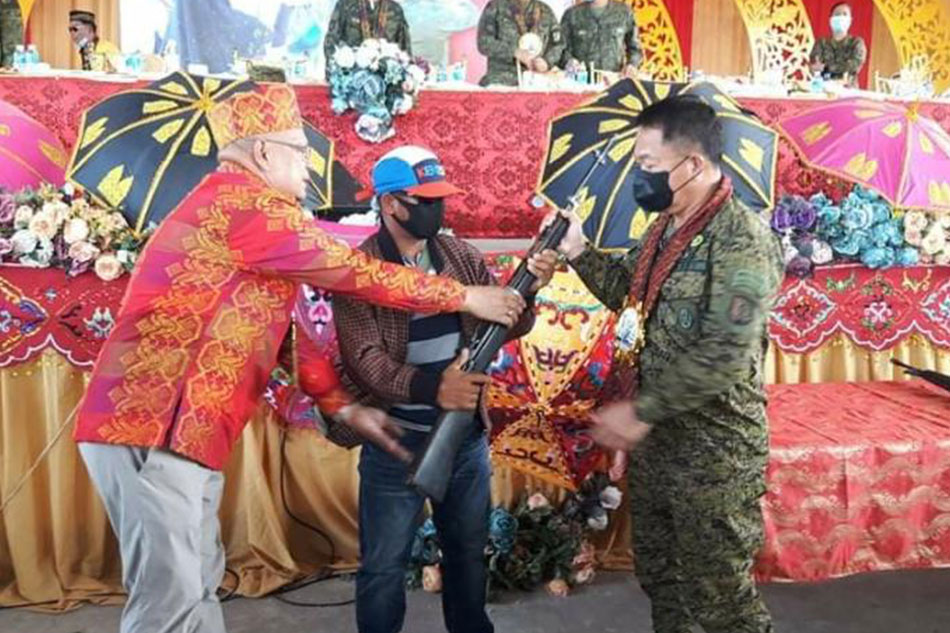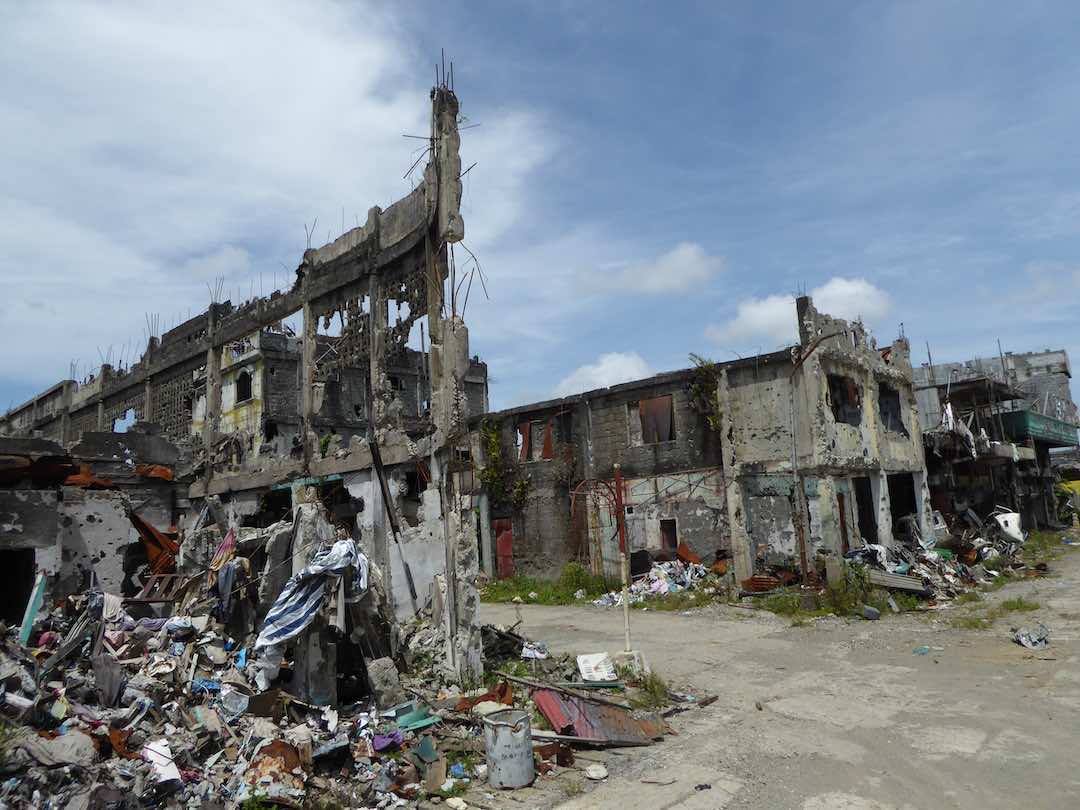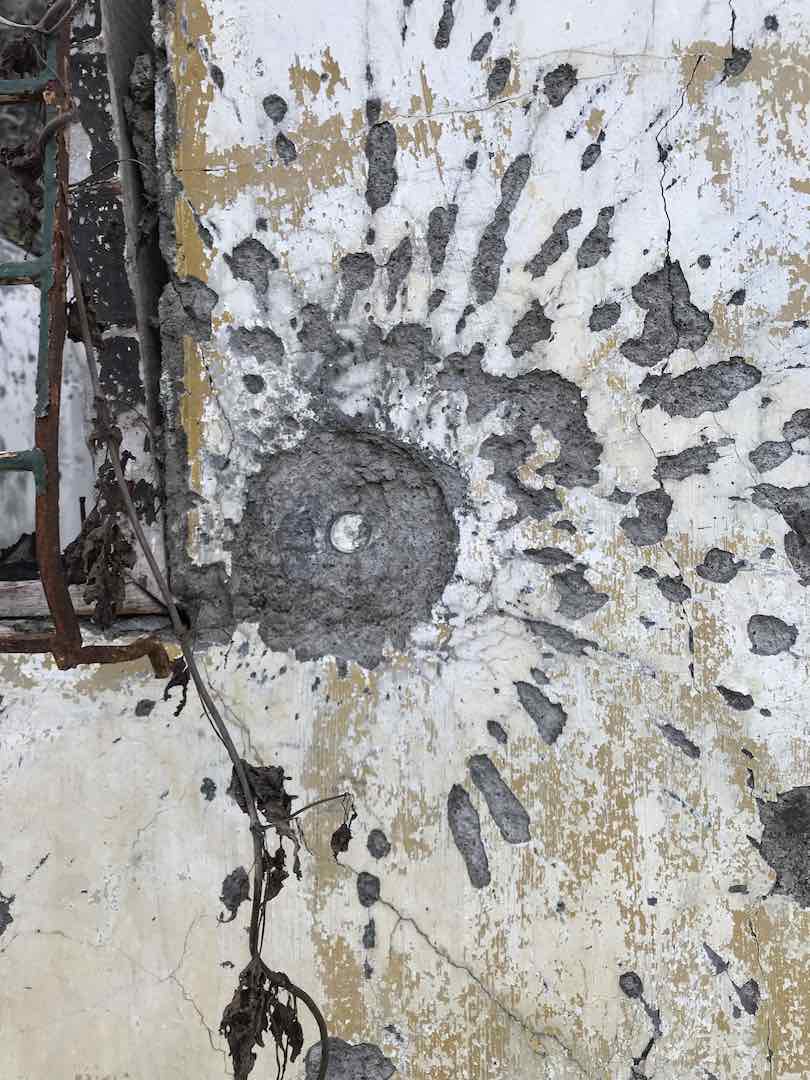Posted to the Asia Times (Oct 29, 2020): Philippines taking aim at China’s sea militias
Manila poised to form new paramilitary marine units to counter China’s ‘gray zone’ tactics in South China Sea (By RICHARD JAVAD HEYDARIAN)

A Philippine soldier conducts a security patrol along Ulugan Bay, facing the South China Sea in Puerto Princesa, Palawan island, south of Manila on April 25, 2012. Credit: AFP/Ted Aljibe
A “gray zone” arms race is emerging in the South China Sea, where China’s rising use of para-military forces to assert its contested claims could soon be met by rival maritime militias from Southeast Asia.
Long outgunned and outspent by China, the Philippines is now moving to create its own militia sea forces, to be known as the Cafgu Active Auxiliary Service (CAAS), to protect its interests in adjacent waters including within its vast exclusive economic zone (EEZ).
The military move, if approved, would come in response to China’s growing use of para-military forces, including the use of small vessels to systematically swarm contested islands and strategic features, to intrude ever deeper into Philippine-claimed waters.
In particular, China has recently used para-military forces to block supplies and construction material shipments from arriving at Thitu Island, where the Philippines maintains a token military presence and rudimentary airstrip it is seeking to upgrade.
Philippine Defense Secretary Delfin Lorenzana said in a recent address to the Senate that “the other side” – meaning China – “is using what we call ‘civilian militias’ but actually are part of their Navy… they’re also fishing, they’re also acting as fishermen and fishing with big boats.”
The Philippines would not be the first to push back at China’s use of maritime paramilitary forces in the sea. Vietnam, which likewise has various South China Sea disputes with China, including in the Paracel and Spratly island chains, created its own maritime militia forces back in 2009.
Both communist regimes view this so-called “gray zone” strategy as part of their “whole of nation” or “people’s war at sea” approach to the increasingly high-stakes maritime spats, which strategic analysts say threaten to spiral into a China-US confrontation for control of the strategic sea.

Chinese paramilitary vessels take to sea. Image: Reddit
The paramilitary strategy, however, also carries big risks of escalation and conflict given long-time concerns over the lack of professionalism and command control of China’s militia forces, particularly in the current climate of rising jingoism and zero-sum competition for the sea’s vast oil, gas and fishery resources.
The Philippines is bidding to firm up its defenses after years of Chinese intimidation tactics in the disputed sea, including China’s 2012 occupation of the Scarborough Shoal in Manila’s EEZ.
The shoal would be crucial for China to establish an Air Defense Identification Zone (ADIZ) over the sea, a move that would potentially provoke a military response from the US, a Philippine mutual defense treaty ally.
Philippine President Rodrigo Duterte underscored the strategic need for more China-countering forces at a speech last month at the United Nations’ General Assembly, where he “firmly reject[ed] attempts to undermine” the Philippines’ maritime claims – a thinly veiled complaint against China’s rising use of sea militias.
Vice Admiral Giovanni Carlo Bacordo, the Philippines’ naval chief, has emerged as the leading top brass voice for taking a tougher stance against China through the formation of what he characterized as “force multiplier” marine militias.
“It’s a stop-gap measure to fill where we are not, where the Navy and where the Coast Guard are not,” said the Philippine navy chief about the formation of the CAAS.
The navy chief said the new force would be a collaborative effort, whereby members of the militia force will be recruited from among the Philippine Army, the dominant branch of the military, but trained by the modernizing Philippine Navy, specifically the navy’s Northern Luzon and Naval Forces West units.
Both naval units are at the forefront of the South China Sea disputes. The Philippine Navy also clarified that the militia forces would have a geographically-specified area of operation to ensure “maximum efficiency” and prevent possible rogue operations.

Philippine Marines pictured at BRP Sierra Madre, a dilapidated Philippine Navy ship that has been aground since 1999 and became a Philippine military detachment on the disputed Second Thomas Shoal, part of the Spratly Islands, in the South China Sea March 29, 2014. Photo: Agencies
“We keep on moving. We patrol the area, then we leave,” he added to reassure already emerging critics that the plan aims only to enhance the Philippines’ domain awareness and surveillance in the disputed waters and will not be deployed for political purposes.
“Definitely, they will not be given firearms,” Rear Admiral Loumer Bernabe, a fleet commander, said in a recent public hearing while emphasizing that the CAAS will only be issued tracking devices and communications equipment in a mainly surveillance and patrol capacity across Philippine-claimed waters.
“The relevance of maritime CAAS is if you’re from Pangasinan, your concern is Pangasinan waters. If you’re from La Union, your concern is La Union waters. You won’t be moving from one place to another,” the Philippine navy chief clarified in a recent public hearing.
The ultimate aim, Bacordo said, is to allow Philippine forces to have “the capability to be everywhere”, with the new militia units acting as “force multipliers” for the professional naval and coast guard forces.
To be sure, Philippine naval forces need all the help they can get.
Defense Secretary Lorenzana noted during a Senate hearing that chronic budget shortfalls meant the armed forces have struggled to fully modernize, having attained only 25% of projects aimed at developing “minimum credible defense” capabilities against external security threats.
As of August 2019, the Philippines’ armed forces had reportedly completed only 21 out of the 152 projects under the first phase of a three-phased “horizons” modernization program, which started in the early 2010s and will continue into the mid-2020s.
The Department of National Defense proposed a 283.2 billion peso ($6 billion) budget for 2021, a pittance compared to the amounts China and other regional rivals with claims in the South China Sea earmark for their armed forces.
But there is now growing congressional support to allocate more resources to push back militarily against China.

Senator Imee Marcos, a staunch Duterte ally and daughter of former strongman Ferdinand Marcos, recently suggested that the Philippine Navy Seals’ Special Operations Group (NAVSOG) could also ramp up its recruitment and involvement in maritime defense operations.
“Let us at least defend our fishermen. Have we given up defending them? We can’t just cower in fear and remain defenseless and vulnerable,” Marcos said in filing a bill to boost funds for the so-called Self-Reliance Defense Posture Program (SRDP), which among other things seeks to enhance domestic arms development capacity.
Others, however, are concerned about the risk of an unaccountable paramilitary unit de facto tasked with going head-to-head with China’s militias. Senator Risa Hontiveros warned that “Those who should be armed in the country should only be the AFP [military] and PNP [police],” and that it’s necessary instead to “beef up the capacity of the Navy and Coast Guard.”
The opposition senator expressed fears that a new militia force would inevitably draw in non-professional Filipino fishermen, providing a greater pretext for China to ramp up its harassment and even violence in the area.
Last year, a suspected Chinese militia vessel sunk and almost killed 22 Filipino fishermen roaming the fisheries and energy-rich contested Reed Bank area.
“They might be targeted more by China,” the senator added in Tagalog. “Not only one fisherman could get killed,” she added.
Jay Batongbacal, a Philippine maritime law expert, has similarly warned that without proper training and clear rules of engagement there is a risk militia forces “might end up with vigilante-like groups or adventurists, which are not the kind of people you want in a tense disputed region.”
Chinese state-affiliated scholars are ringing similar alarms. Chen Xiangmiao, associate researcher with the National Institute for South China Sea Studies, has said that “conflicts between militias or other non-military forces… would probably increase” as claimants ramp up their gray zone operations.

A Philippine soldier patrols a beach in Thitu Island at the Spratly group of islands in the South China Sea. Photo: AFP/Pool/Ritchie B Tongo
The final decision on the militia forces will likely come down to Duterte, who has blown hot and cold on how to handle Beijing’s rising assertiveness in Philippine waters under his perceived as China-friendly tenure.
“The president [Duterte] said that we are not yet ready to do it. He said we should postpone it since we have no budget to sustain it,” Lorenzana told reporters following recent consultations with the national leader, who legally serves as commander in chief.
“First, there’s no money. Second, we don’t know… the money is supposed to procure bigger ships with steel hulls. You cannot use a wooden boat in your militia. They will be destroyed easily,” the defense chief said.
https://asiatimes.com/2020/10/philippines-taking-aim-at-chinas-sea-militias/






















